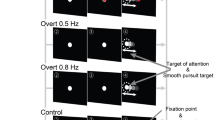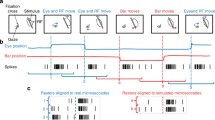Abstract
The ability of the eyes and brain to predict and track visible and occluded moving targets is essential to goal-directed action. Event-related functional MRI and eye-movements were simultaneously measured during a smooth pursuit task with different levels of visual cuing. Subjects tracked a white dot moving from left to right following a sinusoidal pattern, during which it could be seen over half the screen (visible condition) before disappearing behind the occlusion bar (occluded condition). When tracking occluded, moving targets, we observed a hemisphere asymmetry at the early visual cortex, but not in motion-processing area MT/V5. During eye-tracking, the left early visual cortex responded stronger than the right to visible targets, but the right responded stronger to occluded targets. In contrast, motion-processing area MT/V5 in both hemispheres favored visible over occluded targets. These results suggest the right early visual cortex is the mind’s eye, receiving input from higher level memory regions to produce simulated vision during occlusion.




Similar content being viewed by others
References
Andersson, F., Etard, O., Denise, P., & Petit, L. (2004). Early visual evoked potentials are modulated by eye position in humans induced by whole body rotations. BMC Neuroscience, 19, 5–35.
Corbetta, M., & Shulman, G. L. (2002). Control of goal-directed and stimulus-driven attention in the brain. Nature Reviews Neuroscience, 3, 215–229. doi:10.1038/nrn755.
Cox, R. W. (1996). AFNI—software for analysis and visualization of functional magnetic resonance neuroimages. Computers and Biomedical Research, 29, 162–173. doi:10.1006/cbmr.1996.0014.
Ding, J. H., Powell, D., & Jiang, Y. (2007). Tracking visible and occluded moving target: simultaneous eye-movement and fMRI. NeuroImage, 36(S1), 48. doi:10.1016/j.neuroimage.2007.02.034.
Ehrlichman, H., & Barrett, J. (1983). Right hemisphere specialization for mental imagery: a review of the evidence. Brain and Cognition, 2, 55–76. doi:10.1016/0278-2626(83)90029-5.
Ekstrom, L. B., Roelfsema, P. R., Arsenault, J. T., Bonmassar, G., & Vanduffel, W. (2008). Bottom-up dependent gating of frontal signals in early visual cortex. Science, 18, 414–417. doi:10.1126/science.1153276.
Goebel, R., Khorram-Sefat, D., Muckli, L., Hacker, H., & Singer, W. (1998). The constructive nature of vision: direct evidence from fMRI studies of apparent motion and motion imagery. The European Journal of Neuroscience, 10, 1563–1573. doi:10.1046/j.1460-9568.1998.00181.x.
Gold, B. T., Powell, D. K., Liang, X., Jiang, Y., & Hardy, P. A. (2007). Speed of lexical decision correlates with diffusion anisotropy in left parietal and frontal white matter: evidence from diffusion tensor imaging. Neuropsychologia, 45, 2439–2446. doi:10.1016/j.neuropsychologia.2007.04.011.
He, S. (2007). Holes, objects, and the left hemisphere. Proceedings of the National Academy of Sciences of the United States of America, 105(4), 1103–1104. doi:10.1073/pnas.0710631105, Jan.
Jiang, Y., Boehler, C. N., Nönnig, N., Hopf, J. M., Düzel, E., Heinze, H. J., et al. (2008). Spatial–temporal analysis of binding 3D shape perception. Journal of Cognitive Neuroscience, 20(4), 553–562. doi:10.1162/jocn.2008.20050.
Kimmig, H., Greenlee, M. W., Hueth, F., & Mergner, T. (1999). MR-Eyetracker: a new method for eyemovement revording in functional magnetic resonance imaging. Experimental Brain Research, 126, 443–449. doi:10.1007/s002210050751.
Kimmig, H., Ohlendorf, S., Speck, O., Sprenger, A., Rutschmann, R. M., Haller, S., et al. (2008). fMRI evidence for sensorimotor transformations in human cortex during smooth pursuit eye movements. Neuropsychologia, 46, 2203–2213. doi:10.1016/j.neuropsychologia.2008.02.021.
Kosslyn, S. M., Ganis, G., & Thompson, W. L. (2001). Neural foundations of imagery. Nature Reviews. Neuroscience, 2, 635–642. doi:10.1038/35090055.
Kosslyn, S. M., Maljkovic, V., Hamilton, S. E., Horwitz, G., & Thompson, W. L. (1995). Two types of image generation: evidence for left and right hemisphere processes. Neuropsychologia, 33, 1485–1510. doi:10.1016/0028-3932(95)00077-G.
Lencer, R., Nagel, M., Sprenger, A., Sprenger, A., Zapt, S., Erdmann, C., et al. (2004). Cortical mechanisms of pursuit eye movements with target blanking: an fMRI study. The European Journal of Neuroscience, 19, 1430–1436. doi:10.1111/j.1460-9568.2004.03229.x.
Leopold, D. A., & Logothetis, N. K. (1998). Microsaccades differentially modulate neural activity in the striate and extrastriate visual cortex. Experimental Brain Research, 123, 341–345. doi:10.1007/s002210050577.
Martinez, A., Anllo-Vento, L., Sereno, M. I., Frank, L. R., Buxton, R. B., Dubowitz, D. J., et al. (1999). Involvement of striate and extrastriate visual cortical areas in spatial attention. Nature Neuroscience, 2, 364–369. doi:10.1038/7274.
Moutoussis, K., & Zeki, S. (2006). Seeing invisible motion: a human fMRI study. Current Biology, 16, 574–579. doi:10.1016/j.cub.2006.01.062.
Palmer, S. E. (1999). Vision science: Photons to phenomenology. Cambridge, MA: The MIT.
Sack, A., Kohler, T., Bestmann, S., Linden, D. E. J., Dechent, P., Goebel, R., et al. (2007). Imaging the brain activity changes underlying impaired visuospatial judgments: simultaneous fMRI, TMS, and behavioral studies. Cerebral Cortex (New York, N.Y.), 17, 2841–2852. doi:10.1093/cercor/bhm013.
Weissman, D. H., & Woldorff, M. G. (2005). Hemispheric asymmetries for different components of global/local attention occur in distinct temporo-parietal Loci. Cerebral Cortex (New York, N.Y.), 15(6), 870–876. doi:10.1093/cercor/bhh187.
Author information
Authors and Affiliations
Corresponding author
Rights and permissions
About this article
Cite this article
Jiang, Y., Ding, J., Gold, B.T. et al. Hemispheric Asymmetries in Tracking Occluded Moving Targets with the Mind’s Eye: Simultaneous Event-Related fMRI and Eye-Movement Recording. Brain Imaging and Behavior 2, 300–308 (2008). https://doi.org/10.1007/s11682-008-9040-5
Received:
Accepted:
Published:
Issue Date:
DOI: https://doi.org/10.1007/s11682-008-9040-5




